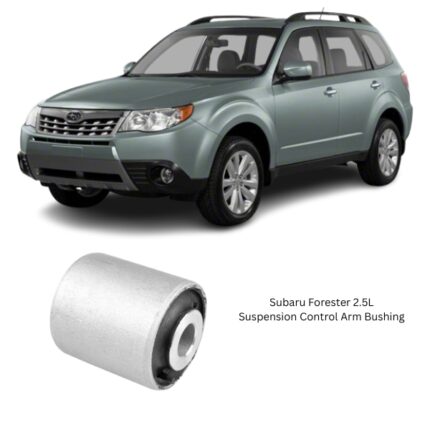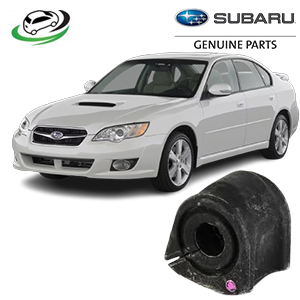Get Subaru Legacy 2009 Front Stabilizer Bush Assy 20414AL000 in Kenya
The front stabilizer bushing assembly, often referred to simply as the stabilizer bushing or sway bar bushing, plays a crucial role in a vehicle’s suspension system. It is designed to enhance the stability and handling of a vehicle, particularly during cornering and other dynamic driving conditions. In this comprehensive guide, we will delve into the functions, benefits, components, signs of wear, maintenance tips, and replacement procedures related to the front stabilizer bushing assembly.
1. What is the Front Stabilizer Bushing Assembly?
The front stabilizer bushing assembly consists of rubber or polyurethane bushings that are mounted on the stabilizer or sway bar. This component serves as a pivot point for the sway bar, allowing it to articulate and providing necessary flexibility while maintaining a secure attachment to the vehicle’s chassis.
Structure and Composition
- Bushings: Typically made of rubber or polyurethane, these bushings are designed to absorb vibrations and reduce friction between the sway bar and the vehicle’s chassis.
- Mounting Brackets: These are metal brackets that secure the bushings to the sway bar and chassis. They help maintain the alignment and stability of the entire assembly.
- Sway Bar: The stabilizer bushing assembly is connected to the sway bar, a critical component that helps control body roll during cornering.
2. Functions of the Front Stabilizer Bushing Assembly
The front stabilizer bushing assembly serves several essential functions within a vehicle’s suspension system:
a. Reducing Body Roll
One of the primary functions of the front stabilizer bushing assembly is to reduce body roll during cornering. The sway bar helps distribute weight more evenly across the vehicle, allowing for improved stability and handling.
b. Enhancing Suspension Performance
The stabilizer bushing assembly contributes to the overall performance of the suspension system. It provides necessary flexibility, allowing the suspension to respond more effectively to changes in road conditions.
c. Improving Steering Response
By stabilizing the vehicle during turns, the front stabilizer bushing assembly helps enhance steering response. This improved feedback allows drivers to maintain better control over the vehicle.
d. Absorbing Road Impacts
The rubber or polyurethane bushings in the assembly absorb vibrations and impacts from the road, providing a smoother ride and reducing the transfer of noise and harshness into the cabin.
e. Preventing Wear on Other Suspension Components
By stabilizing the sway bar and reducing body roll, the front stabilizer bushing assembly helps minimize wear and tear on other suspension components, extending their lifespan.
3. Benefits of a Properly Functioning Front Stabilizer Bushing Assembly
A well-maintained front stabilizer bushing assembly provides numerous benefits, including:
a. Enhanced Vehicle Stability
A functioning stabilizer bushing assembly helps keep the vehicle stable during turns and maneuvers, resulting in improved handling and safety.
b. Improved Ride Comfort
By absorbing road vibrations and impacts, the front stabilizer bushing assembly contributes to a more comfortable ride for both the driver and passengers.
c. Increased Tire Life
Properly functioning stabilizer bushings help maintain even tire contact with the road, reducing uneven tire wear and extending tire lifespan.
d. Better Steering Control
A stable front end allows for better steering control and responsiveness, making for a more enjoyable driving experience.
e. Reduced Risk of Suspension Damage
By preventing excessive body roll and maintaining the alignment of suspension components, a functioning front stabilizer bushing assembly helps reduce the risk of damage to other parts of the suspension system.
4. Signs of a Failing Front Stabilizer Bushing Assembly
Recognizing the signs of a failing front stabilizer bushing assembly is crucial for preventing further damage and maintaining optimal vehicle performance. Common indicators include:
a. Increased Body Roll
If you notice that your vehicle leans excessively during cornering, it may indicate that the stabilizer bushings are worn or damaged.
b. Clunking or Knocking Noises
A failing stabilizer bushing assembly may produce clunking or knocking sounds, particularly when going over bumps or during sharp turns. These noises can be a sign that the bushings have worn out or that there is play in the suspension.
c. Steering Wheel Vibration
If you experience unusual vibrations in the steering wheel while driving, it could indicate an issue with the stabilizer bushing assembly or other components in the suspension system.
d. Uneven Tire Wear
Worn stabilizer bushings can cause uneven tire wear, resulting in the need for more frequent tire replacements.
e. Poor Handling and Stability
A noticeable decline in handling, especially during turns, can indicate that the front stabilizer bushing assembly is no longer functioning effectively.
5. Maintenance of the Front Stabilizer Bushing Assembly
Regular maintenance of the front stabilizer bushing assembly is vital for optimal vehicle performance and longevity. Key maintenance practices include:
a. Routine Inspections
Conduct routine inspections of the stabilizer bushings during regular vehicle maintenance. Look for visible signs of wear, such as cracks or deformation, and check for any loose connections.
b. Monitor Steering and Handling
Pay attention to how your vehicle handles while driving. If you notice changes in steering response or increased body roll, inspect the stabilizer bushing assembly for potential issues.
c. Lubrication
Some stabilizer bushings may require periodic lubrication to reduce friction and wear. Follow the manufacturer’s recommendations regarding lubrication and maintenance intervals.
d. Addressing Noises Promptly
If you hear clunking or knocking noises, address them promptly. Ignoring these sounds can lead to further damage and more expensive repairs.
e. Replacement of Worn Components
If the stabilizer bushings show signs of wear or damage, it is essential to replace them as soon as possible to prevent further issues.
6. Steps to Replace the Front Stabilizer Bushing Assembly
Replacing the front stabilizer bushing assembly is a straightforward process that can typically be performed with basic tools. Here’s a general outline of the steps involved:
1. Gather Necessary Tools
You will need basic hand tools, including a socket set, wrench, torque wrench, and possibly a bushing removal tool. Have the replacement stabilizer bushings on hand.
2. Raise the Vehicle
Using a jack, raise the front of the vehicle and secure it on jack stands. This will provide better access to the stabilizer bar and bushings.
3. Remove the Sway Bar Links
Disconnect the sway bar links from the sway bar using the appropriate socket or wrench. This will allow for easier access to the bushings.
4. Remove the Old Bushings
Locate the old stabilizer bushings on the sway bar. Depending on their design, you may need to use a bushing removal tool to extract them. Carefully remove the old bushings and inspect the sway bar for any signs of damage.
5. Clean the Sway Bar
Before installing the new bushings, clean the sway bar and the area where the bushings will be mounted. This will ensure a proper fit and help prevent premature wear.
6. Install the New Bushings
Place the new bushings onto the sway bar in the same location as the old ones. Ensure that they are oriented correctly according to the manufacturer’s specifications.
7. Reattach the Sway Bar Links
Reconnect the sway bar links to the sway bar, ensuring that all bolts are tightened to the manufacturer’s torque specifications. Properly securing the links will help maintain the stability and functionality of the suspension system.
8. Lower the Vehicle
Once everything is reassembled, carefully lower the vehicle back to the ground. Ensure that all components are secure and that there are no tools left under the vehicle.
9. Test Drive the Vehicle
After replacing the front stabilizer bushing assembly, take the vehicle for a test drive. Monitor for any signs of improved handling, reduced noise, or any lingering issues.
Conclusion
The front stabilizer bushing assembly is a critical component of a vehicle’s suspension system, contributing significantly to stability, handling, and ride comfort. Understanding its functions, benefits, maintenance practices, and signs of wear can help vehicle owners take proactive steps to ensure their vehicles remain in optimal condition. Regular inspections, timely replacements, and proper maintenance of the front stabilizer bushing assembly contribute to improved vehicle performance, increased longevity, and a safer driving experience. By keeping this essential component in good condition, drivers can enjoy the peace of mind that comes with a well-functioning suspension system.
Follow us on Facebook for more parts.




Reviews
Clear filtersThere are no reviews yet.